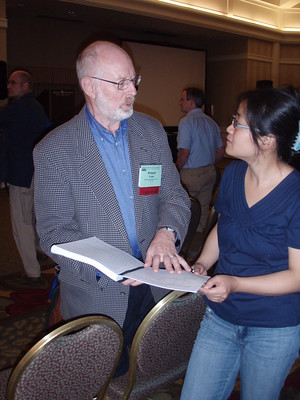Instead of OSCON, I was invited to AAPT this year, the semi-annual meeting of the American Association of Physics Teachers (all levels). They're meeting at the Hilton downtown, taking over the conference rooms, including two across the street in the executive tower.
I've been bouncing around with Dr. Bob Fuller, made it a few minutes late to his talk this morning, where he yakked about First Person Physics some, even had my name on a slide (woo hoo!). Yesterday, he made a special point of asking to see student project six in a lecture, a Youtube about the Geodesic Dome. This was from Dr. Milner-Bolotin's project, University of British Columbia, wherein students get to make Youtubes about their projects.
Yes, physics teachers are on top of the new tools, way more tools than I'd heard of. Not all of them use Youtube or Facebook, but a lot of them do, and are encouraging their peers to craft an ePortfolio, not just for themselves, but for their courses. I was impressed by the gung ho attitude. Future shock is to be taken in stride.
When one high school physics teacher was asked about the frequent practice of blocking Youtube at the district level, even for teachers, the panelist pulled no punches: start a revolt, she said. Schools can't claim to be institutions of learning if they censor to that degree, are day care centers at best.
Dr. Fuller thinks it's important to tell more compelling stories when setting up some iconic physics situations that are going to yield up a wealth of insights into principles. He is also very supportive of using physics to support life sciences majors. This was a theme of First Person Physics in the form of Dr. Urone's work as well. He was there, showing off the new electronic textbook software behind his latest work.
I know Tara would have enjoyed some of these talks, maybe the one on microscopy especially. The woman delivering that talk, Jennifer L. Ross, University of Massachusetts, came across as one truly brilliant geek. I also watched Duane L. Deardorff, at University of North Carolina at Chapel Hill, juggle five balls (with some fine physics to go with). The talk on bridge failures, which Dr. Fuller was keen to see (Tacoma Narrows is one of his foci), was likewise engaging. Physicists / physics teachers, are an eclectic and dedicated group.
In terms of state standards, there's already some chafing at being normalized as a Physical Science (like chemistry) as opposed to a Life Science. That's an opposition the AAPT seems eager to deny, as Physics and the Life Sciences are closer than hand-in-glove these days. The human heart kept being a focus. EEGs, MRIs... physicists want to help with the practice of medicine. So having the state standards draw a line in the sand... oh well, there's still room for individual schools to best the standards (they set a floor, not a ceiling).
On the way back (I walked home), I stopped into Lucky Lab and had a meeting with a community college software guy. Their shop rolled its own administrative software, starting with a mainframe running FORTRAN, all home grown. Just as he was leaving, a vendor product raised its ugly head, some political wheeling and dealing forced it down their throats. The old guard was still seeing ways to work around it though, as this product was truly lame. They'd stuff it with data at the end of the day, but from more authoritative in-house sources.
Forgive the shop talk, this was a theme on edu-sig this month.

